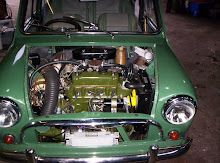Although the thermostat which regulates the cooling water temperature vitally affects engine efficiency it is often overlooked and seldom checked. As can be seen from Fig. 16, it consists of a valve, fitted at the water outlet from the cylinder head, that prevents circulation of water to the radiator until the normal running temperature is reached.
The bellows, filled with wax or a volatile liquid, begins to expand at a temperature of 82°C, in the case of the standard model. An alternative thermostat which opens at 88°C can be substituted during cold weather. The higher opening temperature of the latter improves the efficiency of an interior heater and can also cause an appreciable improvement in fuel consumption during winter driving. A thermostat which opens at 74°C is available for use in hot climates.
Thermostats, of course, are not infallible and if overheating occurs, or conversely, if the engine is slow to warm-up, it is logical to check this item. Remember, however, that overheating can be caused by a number of other faults, among which deposits of rust and lime scale in the cylinder head and radiator water passages are the most likely. Shortage of oil or water, obstructed air passages in the radiator, over-retarded ignition and severe pinking will also cause the trouble.
The thermostat can be lifted out after the water outlet elbow has been removed. When cold the valve should be tightly closed. If it is open, either the bellows is punctured or the stem is jammed by an accumulation of lime deposits.
If the thermostat appears to be serviceable, it should be tested by immersing it in a pan of water which should be brought nearly up to boiling point. If a suitable thermometer is available the opening temperature should be checked while moving the thermostat about in the water to ensure even heating; the temperature will, of course, depend on the type of thermostat fitted, as described above. If the valve has not opened when the water begins to boil a replacement thermostat should be fitted. Before refitting a used thermostat make sure that llie small air-release hole in the valve is not choked; otherwise an air-lock is likely to occur when the cooling system is refilled.
Saturday, 17 October 2009
The Thermostat
Labels: thermostat
Posted by Info Mini Cars at 04:06
Subscribe to:
Post Comments (Atom)


0 comments:
Post a Comment